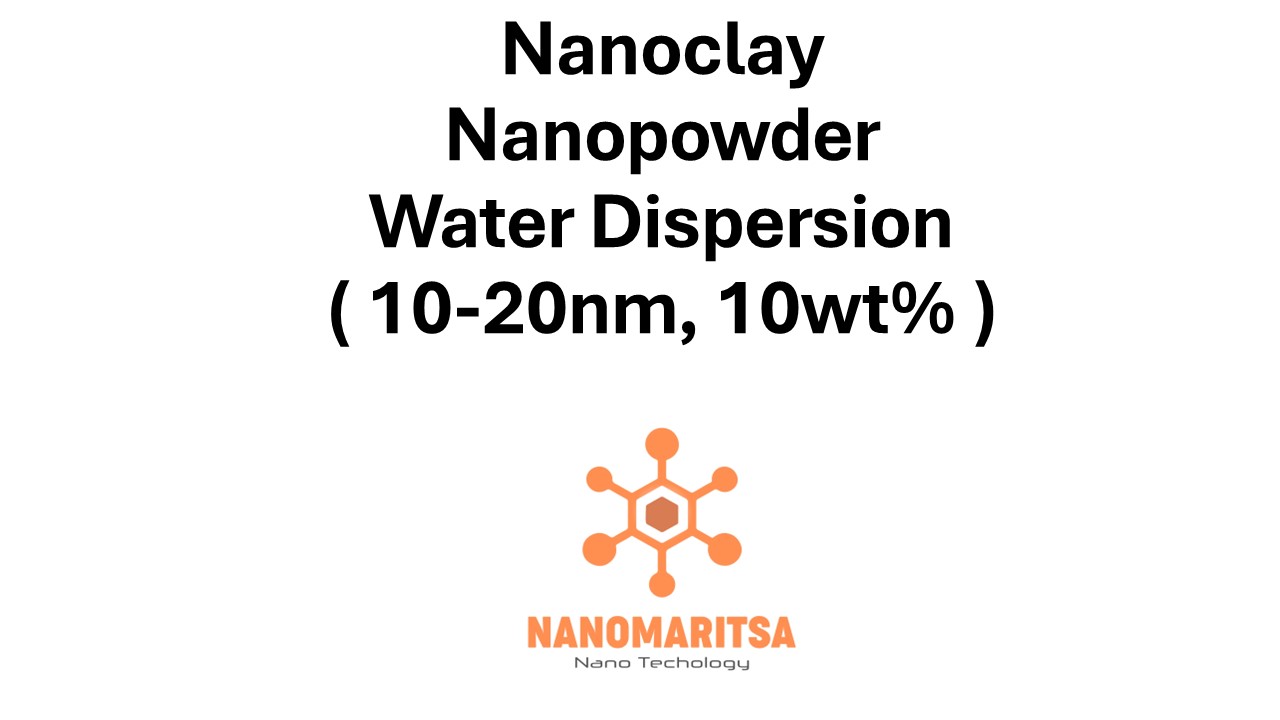Nanoclay Nanopowder Water Dispersion (10-20nm, 10wt%) is a colloidal solution containing nanoclay particles suspended in water. Here’s a detailed breakdown of its key features and applications:
- Key Features:
- Nanoclay: The dispersion contains nanoclay, which refers to naturally occurring clay materials with a nanometer-sized structure. These clays are often composed of mineral compounds such as montmorillonite, kaolinite, or halloysite.
- Nanoparticles: The clay particles in the dispersion range in size from 10-20 nanometers (nm). This size range offers a high surface area, which increases the material’s reactivity and interaction potential.
- Water Dispersion: The nanoclay particles are evenly suspended in water, forming a stable colloidal solution. Stabilizers are often used to prevent the particles from clumping or settling.
- Concentration: The dispersion has a 10 wt% (weight percent) concentration, meaning the solution contains 10 grams of nanoclay nanoparticles per 100 grams of solution.
- Properties:
- High Surface Area: The 10-20 nm size of the nanoclay particles significantly increases their surface area, which enhances their effectiveness in various applications, particularly in improving the properties of composites, coatings, and other materials.
- Clay Properties: Nanoclay materials exhibit unique properties, such as ion-exchange capacity, high surface reactivity, and the ability to form stable nanocomposites.
- Stability: The dispersion is stabilized to maintain a uniform distribution of nanoparticles, preventing agglomeration and ensuring consistent performance.
- Applications:
- Nanocomposites: Nanoclay nanoparticles are widely used to enhance the mechanical, thermal, and barrier properties of polymer-based composites. When incorporated into plastics, rubber, or other materials, they can improve strength, stiffness, and resistance to wear, corrosion, and heat.
- Coatings: Due to their excellent barrier properties, nanoclays are often used in protective coatings for corrosion resistance, water resistance, and durability. This makes them ideal for applications in automotive, aerospace, and construction industries.
- Environmental Remediation: Nanoclay particles can be used for environmental applications such as water purification, soil remediation, and wastewater treatment due to their ability to adsorb pollutants, including heavy metals and organic compounds.
- Drug Delivery Systems: Nanoclays are used in the pharmaceutical industry for controlled drug delivery. Their high surface area allows for efficient encapsulation of drugs and the controlled release of active substances over time.
- Oil and Gas Industry: Nanoclay particles are used in drilling fluids and other applications in the oil and gas industry, where they help stabilize boreholes, improve lubrication, and enhance the overall efficiency of drilling processes.
- Handling and Safety:
- Toxicity: Nanoclay materials are generally considered non-toxic, but, like all nanoparticles, proper precautions should be taken to avoid inhalation, ingestion, or skin contact. It is important to follow safety protocols when handling the dispersion.
- Storage: The dispersion should be stored in a cool, dry place, away from heat and moisture, to prevent any instability or aggregation of the nanoparticles.
- Precautions: Wear appropriate personal protective equipment (PPE) such as gloves, goggles, and lab coats when handling the dispersion. Work in a well-ventilated area or under a fume hood to avoid exposure to airborne particles.
With a concentration of 10 wt%, this nanoclay dispersion offers a high concentration of nanoparticles, making it suitable for high-performance applications in nanocomposites, coatings, environmental remediation and more.
SKU: MN07MPD0220
Category: Metal Dispersions
| Measurement (ml) | 100 ml, 500 ml, 1000 ml |
|---|
Related products
-
Metal Dispersions
Germanium Nanopowder Water Dispersion (Ge, 30-40nm, 1000ppm )
0 out of 5(0)SKU: MN07MPD0217€760.00 This product has multiple variants. The options may be chosen on the product page -
Metal Dispersions
Sulphur Nanopowder Water Dispersion (S, 40-50nm, 10wt% )
0 out of 5(0)SKU: MN07MPD0219€130.00 This product has multiple variants. The options may be chosen on the product page -
Metal Dispersions
Silver Ag Nanopowder Water Dispersion (Ag, 15 nm, 50000ppm)
0 out of 5(0)SKU: MN07MPD0206€320.00 This product has multiple variants. The options may be chosen on the product page -
Metal Dispersions
Diamond (C) Nanopowder Water Dispersion (3nm, 5wt% in Water)
0 out of 5(0)SKU: MN07MPD0216€680.00 This product has multiple variants. The options may be chosen on the product page






